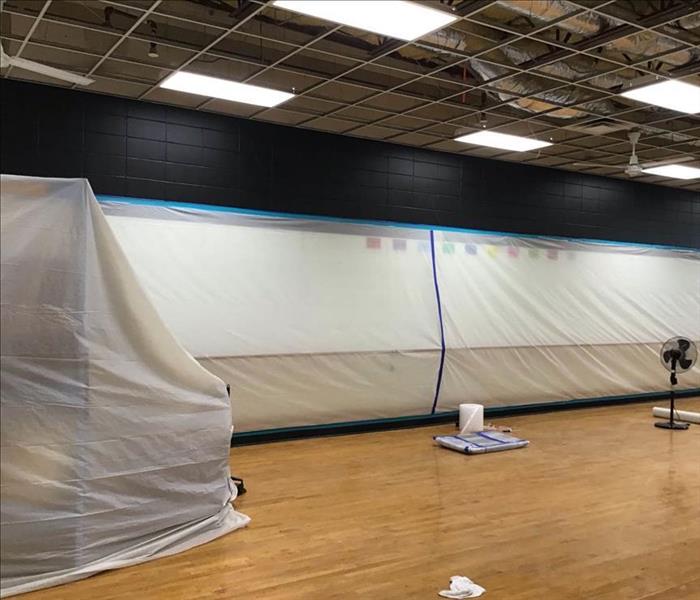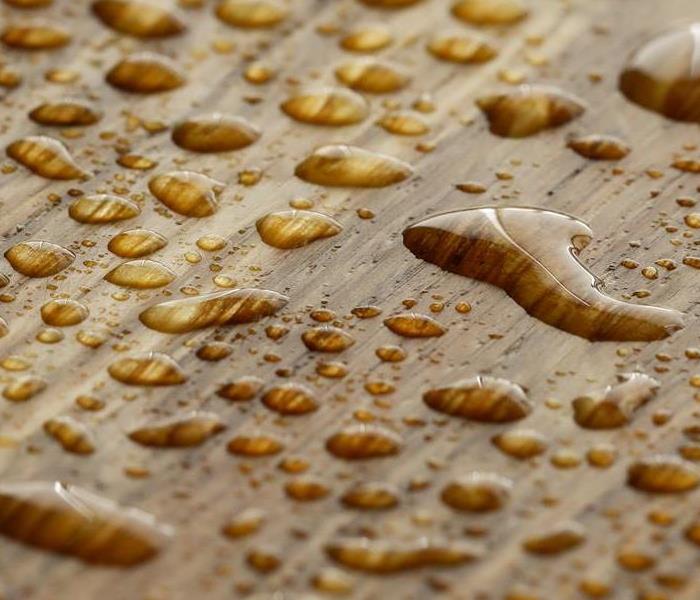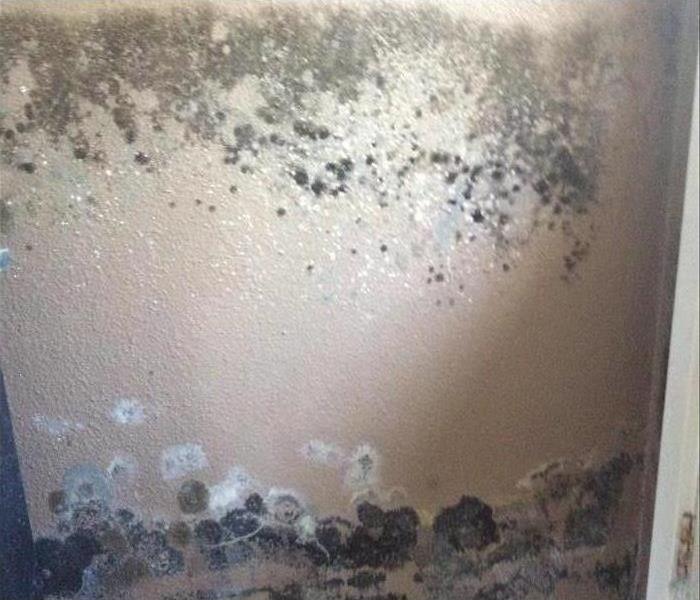Archived Mold Remediation Blog Posts
Why Does Persistent Mold Keep Coming Back?
11/19/2023 (Permalink)
 If you have taken all the necessary steps to prevent mold but it keeps coming back, it's beneficial to consult with a professional mold specialist.
If you have taken all the necessary steps to prevent mold but it keeps coming back, it's beneficial to consult with a professional mold specialist.
Dealing with recurring mold growth can be frustrating. Whether it's in your bathroom, kitchen, or any other area of your home, understanding why mold keeps coming back is essential to effectively address the issue. In this blog, we will explore some common reasons behind the persistence of mold growth, without mentioning any health risks or concerns.
Moisture and Humidity
Mold thrives in moist and humid environments. If mold keeps reappearing, it indicates that there may be underlying moisture issues. Leaky pipes, roof leaks, or poor ventilation can contribute to excessive moisture and create a favorable environment for mold growth. To prevent the recurrence of mold, it's crucial to identify and fix the sources of moisture. Repair any leaks promptly, improve ventilation in areas prone to high humidity, and use dehumidifiers if necessary.
Inadequate Cleaning
Improper cleaning can also be a contributory factor in recurring mold growth. Superficially removing visible mold without addressing the spores and mold colonies can lead to its re-emergence. It's essential to thoroughly clean affected surfaces, using appropriate cleaning agents specifically designed for eliminating mold. Ensure that you scrub effectively and reach all the nooks and crannies where mold can hide. Additionally, using mold-resistant products for repairing or renovating areas prone to mold growth can help prevent future occurrences.
Insufficient Drying
After cleaning, it is crucial to allow the affected areas to dry completely. Moisture can remain in hidden or hard-to-reach areas, providing an opportunity for mold to regrow. Insufficiently drying surfaces or materials affected by water damage can contribute to recurring mold problems. Properly ventilate the area, use fans, and dehumidifiers as needed to promote thorough drying. Be thorough in addressing any water intrusion or condensation issues and ensure that affected areas are completely dry before closing them off.
Poor Maintenance
A lack of regular maintenance can also contribute to the recurrence of mold. Neglecting routine cleaning and upkeep can allow mold to grow unabated. Regularly inspect your home for any signs of water damage, leaks, or areas with high humidity. Promptly address these issues and take preventive measures such as applying mold-resistant products, regularly cleaning and drying vulnerable areas, and maintaining proper ventilation. By being proactive in maintenance, you can minimize the conditions that facilitate mold growth and reduce the chances of it coming back.
In some cases, the persistence of mold growth may indicate a larger underlying problem, such as structural issues or extensive water damage. If you have taken all the necessary steps to prevent mold but it continues to come back, it may be beneficial to consult with a professional mold remediation specialist. These experts have the knowledge and expertise to assess the situation, identify any hidden sources of moisture, and implement appropriate remediation measures. They can help you address the root cause of the mold problem and ensure a long-term solution, providing you with peace of mind and a mold-free environment in your home.
Tips and Tricks on Preventing Water Damage to Keep Your Home Mold-Free
5/14/2023 (Permalink)
 Preventing water damage is one of the best ways to prevent mold growth in the home.
Preventing water damage is one of the best ways to prevent mold growth in the home.
Water damage is a common problem that homeowners face, especially in areas with heavy rainfall or prone to flooding. Water damage can occur due to a variety of reasons, including burst pipes, leaking roofs, or flooding. When water enters a home, it can seep into walls, ceilings, and floors, creating a moist environment that is conducive to mold growth.
Water damage and mold growth
Mold is a type of fungus that grows in damp and humid environments. When mold spores come into contact with moisture, they can quickly multiply and spread, causing damage to surfaces and structures in the home.
Preventing water damage is one of the best ways to prevent mold growth in the home. By preventing water from entering the home, homeowners can create an environment that is less hospitable to mold growth. Here are some ways that preventing water damage can help prevent mold.
Repair leaks promptly
Leaks from pipes, roofs, and windows can allow water to enter the home and create a damp environment that is conducive to mold growth. By repairing leaks promptly, homeowners can prevent water damage and reduce the risk of mold growth.
Keep gutters and downspouts clean
Gutters and downspouts are designed to channel water away from the home. If they are clogged with leaves and debris, water can back up and overflow, causing damage to the roof and walls. Keeping gutters and downspouts clean can prevent water damage and reduce the risk of mold growth.
Use a dehumidifier
High humidity levels can create a damp environment that is conducive to mold growth. Using a dehumidifier can help to reduce humidity levels and prevent mold growth.
Install proper ventilation
Proper ventilation is important in areas of the home that are prone to moisture, such as bathrooms and kitchens. Installing ventilation fans can help to remove excess moisture and prevent mold growth.
Inspect the home regularly
Regular inspections of the home can help to identify potential sources of water damage, such as leaks or cracks in the foundation. Addressing these issues promptly can prevent water damage and reduce the risk of mold growth.
The importance of preventing water damage
Preventing water damage is not only important for preventing mold growth, but it can also help to protect the structural integrity of the home. Water damage can weaken the structure of the home, causing damage to walls, ceilings, and floors. By preventing water damage, homeowners can ensure that their home remains safe and secure.
Preventing water damage is the key to keeping your home safe and mold-free
Preventing water damage is one of the best ways to prevent mold growth in the home. By repairing leaks promptly, keeping gutters and downspouts clean, using a dehumidifier, installing proper ventilation, and inspecting the home regularly, homeowners can create an environment that is less hospitable to mold growth. Preventing water damage is not only important for preventing mold growth, but it can also help to protect the structural integrity of the home. By taking steps to prevent water damage, homeowners can ensure that their home remains safe, secure, and mold-free.
Understanding How Mold Spreads in a House
12/29/2022 (Permalink)
 Mold damage in a Whitehouse, TX home
Mold damage in a Whitehouse, TX home
How Mold Spreads in a House
Mold is a common household problem. Each year, 9 million homes across the U.S. have water damage that causes mold growth. Mold can enter your house through cracks in the foundation or walls, gaps around pipes and wires, or even tiny openings in windows and doors that weren’t properly sealed during construction. Once it’s inside your home, mold spores can spread quickly throughout the building because they get everywhere.
How Mold Spreads
Mold spreads through spores. Spores are tiny pieces of mold that are released into the air or on surfaces in your Whitehouse, TX home, and they can travel quite a distance before they land. Spores are invisible to the naked eye so you may not know that they're floating around your house until they've already begun to grow into new molds.
Active vs. Inactive Mold
Active mold is known as a "hyphal" form of the fungus. This is what you see growing on your moldy bread, or in the corner of your shower stall. In fact, if you open your bathroom cabinet and see what looks like white cotton balls growing on some old papers inside—it's more than likely that you have active mold in there.
If left alone, this type of fungal growth will continue to spread across surfaces until it reaches every nook and cranny of your home (which means it can grow behind walls too). If any part of its "root system" gets exposed to moisture or warm temperatures (like those found near furnaces), it's likely that other sections will begin growing again as well!
Inactive mold doesn't look quite as gross when compared with active mold; however it can still cause health problems if ingested by humans or pets who may come into contact with contaminated surfaces/dust particles floating around them (such as cats licking themselves after rolling around on bedsheets covered with spores). This type usually occurs during rainy seasons because rainwater contains nutrients needed for survival amongst different types of organisms such as fungi species.
Mold Spreads Quickly
Mold spreads throughout a house quickly. It can travel through the air, water, or people's clothing. Mold spores are microscopic and can float in the air for several days before landing on an object to begin growing. They also float around in water and attach themselves onto wet surfaces like walls and floors - even if those surfaces aren't visibly damp anymore!
Preventing Mold Growth
In order to prevent mold growth, you should keep your home clean. Mold spreads quickly in a dirty environment. It also thrives in places with high humidity and moisture content. You should make sure that there is enough ventilation in your house so that the air can dry out properly, preventing mold from growing on surfaces such as carpets or furniture.
Mold spores are everywhere but only grow into colonies if their conditions are right. Keep pets out of affected areas until they have been cleaned up; they will often track spores throughout the house on their paws or fur!
If water damage occurs (such as leaks from roof top downpipes), clean it up immediately before it has time to seep into wall cavities where it won't be noticed until later when there's already too much damage done by then.
 If you have taken all the necessary steps to prevent mold but it keeps coming back, it's beneficial to consult with a professional mold specialist.
If you have taken all the necessary steps to prevent mold but it keeps coming back, it's beneficial to consult with a professional mold specialist.



 24/7 Emergency Service
24/7 Emergency Service

